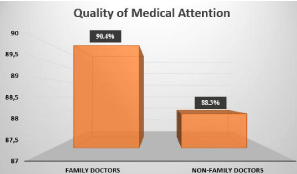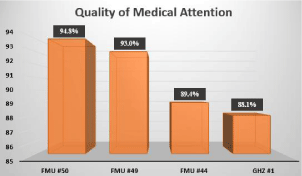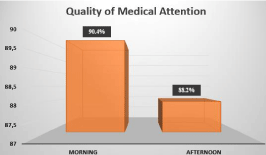Abstract
Background: Satisfaction is a component of paramount importance in health systems; today the basis of medical attention is focused on the family physician who receives more training on the patient doctor relationship.
Aim: The purpose of this study is to compare the perception of satisfaction in the quality of care received by patients of family and non-family doctors in general hospital zone #1, family medicine unit #44, #49 and #50 in Durango, Mexico.
Design and Setting: Comparative cross-sectional study.
Methods: In 450 patients in the General Hospital Zone #1, family medicine unit #44, #49 and #50 in Durango, Mexico; the following variables were measured: age, sex, marital status, schooling, type of medical specialist, working hours and perception of the quality of medical attention. Patients were divided into two groups according to the medical attention (family doctor and non-family doctor) in order to determine differences in the perception of quality of care. For statistical analysis, association was established with T-Student test for statistical significance, it was used 95% interval confidence (p‹0.05).
Results: The perception of the quality of medical care for family doctors was 90.42% and for non-family doctors was 88.39%. There was a better satisfaction in family doctors but the result was not statistically significant (p=0.103).
Conclusion: The global perception in the quality of care by family and nonfamily doctors in the IMSS Durango was 89.4%. Durango is above the national average. There was no difference between medical attention by family and nonfamily doctors.
Keywords: Medical Attention; Family Doctors; Quality of Care
Introduction
The specialist in family medicine is the most qualified doctor in humanistic medical care. Family doctors have been characterized by exercising correctly the doctor-patient relationship, which represents one of the main characteristics compared to non-family doctors [1]. In recent years, patient satisfaction in medical care has become a relevant issue, for that reason, measurements have been made in order to improve the quality of medical care. Patient satisfaction at the Instituto Mexicano del Seguro Social (IMSS) is changing, for this reason, it is important to assess the perception that the patient has to detect the most relevant aspects that influence a poor perception of the quality of medical care in order to improve it. The specialty of family medicine has a bad status compared to other specialties; in Mexico, few students decide to train as family doctors, which conditions a deficit of doctors in primary care and can affect the development of health [2].
An element called doctor-patient relationship intervenes in the satisfaction of the patient. In the doctor-patient relationship, many elements come together in the meeting, the life trajectories, the institutional context of the health services, the kinship relations and the material and discursive environment of the specific historical moment. One of the most relevant components of the relationship is verbal and non-verbal communication, through which knowledge, feelings and sensations are transmitted [3].
The three dimensional model of doctor-patient communication [4] considers three levels that occur simultaneously in the course of the medical act: biomedical, emotional and cultural identity. The effective practice of medicine requires rigorous training in the biomedical dimension, under this approach; it is convenient to practice with the best medical evidence available. In the emotional dimension, the role of emotions in communication during medical attention is analyzed to generate empathy. The patients expect from the doctor an emotional and social support, for which the doctors are not formally trained. In the dimension of cultural identity, communication is established based on knowledge of the patient's life history. This is achieved when the doctor allows the space for the patient to express their point of view and reflect on their life trajectory before and after the illness [5].
The systematic evaluation of patient care allows us to issue a judgment to prevent and correct aspects of medical care that affect the quality and efficiency of medical activity. The main objective was to compare the perception of satisfaction in the quality of care received by patients of family and non-family doctors in general hospital zone #1, family medicine unit #44, #49 and #50 in Durango, Mexico.
Materials and Methods
A comparative cross-sectional study was carried out, in the General Hospital of Zone #1, of the Instituto Mexicano del Seguro Social (IMSS), located in Durango, Mexico from October to December 2016; in patients which were selected by a consecutive sampling techniques; that met the following inclusion criteria: age greater than 18 years, any sex, belong to the Family Medicine Unit (FMU) #1, #44, #49 or #50, that accepted and signed an informed consent; patients with psychiatric illness, incapacity for work or attended by general doctors were not included and eliminated those who did not complete the survey or those with incomplete information.
The following data were obtained directly from the patients or medical records: age, sex, marital status, schooling, type of medical specialist, working hours and perception of the quality of medical attention. The procedure for the data collection was as follows: age was calculated in years according to the year of birth; sex was determined by the phenotype characteristics of each individual; marital status was expressed by each patient; schooling was determined by asking the last degree of studies; type of medical specialist was determined by asking directly to doctors, working hours was determined by the work schedule, was divided into morning and evening and perception of the quality of medical attention was evaluated with Quality Assessment Evaluation Card (QAEC).
QAEC test was established by the department of medical benefits for the program of recognition of quality care of physicians, stomatologists and maxillo-facial Surgeons; this instrument evaluates the satisfaction of the patient according to the medical care received by doctors, the questions were read exactly as they are in the questionnaire, without interpretations, following the order of the questions to avoid omission of any question, without suggesting any possible answers. To obtain the number of qualified criteria, only the total number of questions with a "yes" answer and the total number of questions with a "no" answer should be added. In a second step, we must add the points of each answer; the answer "yes" will have a value of two points; the "no" answers will have one point value. The maximum possible rating means the qualification that would be had in case each qualified criterion obtained points, to determine it, multiply the number of criteria qualified by two. The final percentage score must be calculated, for this purpose, 100 must multiply the score obtained by the participant and this result divided by the maximum possible rating, a higher percentage means greater satisfaction in the quality of medical attention.
The recollected data was integrated into data collection sheets and analyzed using the SPSS program version 20 in Spanish, where we applied descriptive statistics; for qualitative variables, frequencies and percentages were used and for quantitative variables, mean and standard deviation were used. For the bivariate analysis, the T-Student test was used in the quantitative variables to determinate statistically significant differences between medical specialists. The Kolmogorov- Smirnoff test was used to establish the normality of the data. It was considered a p< 0.05 as statistically significant, with a 95% confidence interval. The Protocol was authorized by the Local Committee of Research and Ethics in Health Research from the Regional General Hospital #1, where this study took place.
Results
We analyzed a sample of 450 patients who belonged to the general hospital of zone #1 and the family medical units #44, #49 and #50. 50% (n=225) of the participants were attended by the family doctor and the other 50% (n=225) by a non-family doctor; 50% (n=225) of the interviews were in the morning and 50% (n=225) in the afternoon. The perception of the quality of medical care for family doctors was 90.42% and for non-family doctors was 88.39%. There was a better satisfaction in family doctors but the result was not statistically significant (Graphic 1).

Graphic 1: Quality of medical attention and type of medical specialist.
Satisfaction in family medicine units was distributed in the following descending order (Graphic 2): FMU #50 (94.87%), FMU #49 (93.09%), FMU #44 (89.46%) and FMU #1 (88.12%). The satisfaction perceived according to the working hours (family and non-family doctors) was the following (Graphic 3): morning with 90.46% and evening with 88.26%. According to marital status, the frequency of married was 73.3% (n=550), single 12.4% (n=56) and divorced or widowed 14.2% (n=64). In sex, 25.6% (n=115) were men and 74.4% (n=335) women. In schooling, the highest percentage was observed in secondary school with 32% (n=144), high school 25% (n=112), bachelor 23% (n=105) and primary 20% (n=89).

Graphic 2: Quality of medical attention and family medicine units.

Graphic 3: Quality of medical attention and working hours.
Discussion and Conclusion
According to the results obtained, the perception in the quality of care by family and non-family doctors in the IMSS Durango was 89.4%; in 2018, the national satisfaction survey (ENSAT) of IMSS showed 85% satisfaction at the national level [6], Durango is above the national average. It is convenient to clarify that this study was cross-sectional so it only measures a moment in time, so the results should be interpreted with care, since it only represents the opinion that patients expressed during their medical attention.
Based on the above, we can conclude that the patient perceives greater satisfaction in the quality of care by family doctors compared to non-family doctors in the IMSS Durango. In this study was observed that when the doctor interrogates, explores or performs information, education and communication actions, there is an increase in the perception of quality in the care and when the doctor does not perform an interrogation, explores or does not perform actions, the user perceives poor quality. The doctor-patient relationship plays an important role in the dynamics of the perception of quality in medical care.
References
- Segredo A, Perdomo C. La medicina general integral y su enfoque social y humanista. Educ Med Super. 2012; 26: 294-306.
- Varela-Rueda CE, Reyes-Morales H, Albavera-Hernández C, Díaz-López HO, Gómez-Dantés H, García-Peña C. La medicina familiar en México: presente y futuro.Gac Med Mex. 2016; 152: 135-140.
- Martín-Fernández J, Del Cura-González MI, Gómez-Gazcón T, Fernández- López E, Pajares-Carbajal G, Moreno-Jiménez B. Patient satisfaction with the patient-doctor relationship measured using the questionnaire (PDRQ-9). Aten Primaria. 2010; 42: 196-203.
- Sandoval E, García S, Duran V, Hernández I, Hamui A, Grijalva M, et al. Las tres dimensiones de la comunicación médico-paciente: biomédica, emocional e identidad cultural. CONAMED. 2015; 20: 17-26.
- Salinas-Oviedo C, Laguna-Calderón J, Mendoza-Martínez MR. La satisfacción laboral y su papel en la evaluación de la calidad de la Atención Medica. Salud Pública Mex. 1994; 36: 22-29.
- Instituto Mexicano del Seguro Social. Encuesta Nacional de Satisfacción 2018 (ENSAT). Departamento de prestaciones medicas. 2018.
